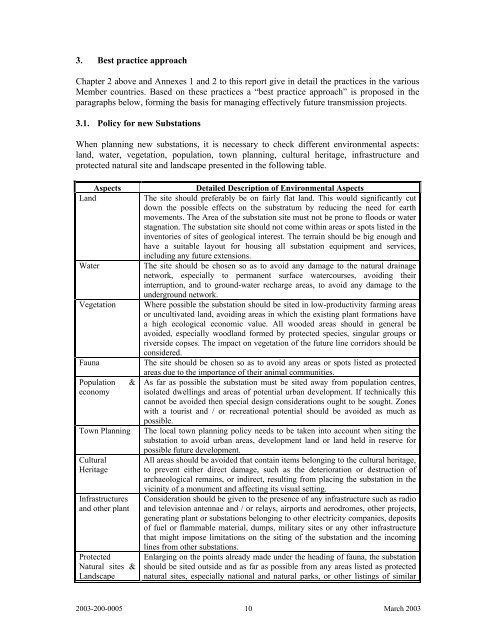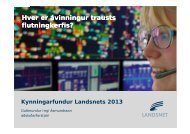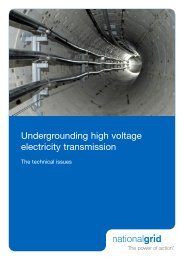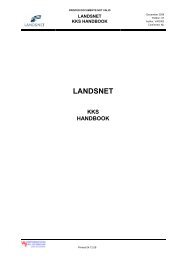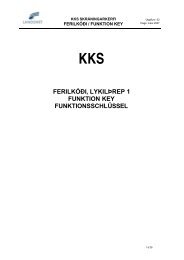Public Acceptance for new transmission overhead lines ... - Landsnet
Public Acceptance for new transmission overhead lines ... - Landsnet
Public Acceptance for new transmission overhead lines ... - Landsnet
Create successful ePaper yourself
Turn your PDF publications into a flip-book with our unique Google optimized e-Paper software.
3. Best practice approach<br />
Chapter 2 above and Annexes 1 and 2 to this report give in detail the practices in the various<br />
Member countries. Based on these practices a “best practice approach” is proposed in the<br />
paragraphs below, <strong>for</strong>ming the basis <strong>for</strong> managing effectively future <strong>transmission</strong> projects.<br />
3.1. Policy <strong>for</strong> <strong>new</strong> Substations<br />
When planning <strong>new</strong> substations, it is necessary to check different environmental aspects:<br />
land, water, vegetation, population, town planning, cultural heritage, infrastructure and<br />
protected natural site and landscape presented in the following table.<br />
Aspects Detailed Description of Environmental Aspects<br />
Land The site should preferably be on fairly flat land. This would significantly cut<br />
down the possible effects on the substratum by reducing the need <strong>for</strong> earth<br />
movements. The Area of the substation site must not be prone to floods or water<br />
stagnation. The substation site should not come within areas or spots listed in the<br />
inventories of sites of geological interest. The terrain should be big enough and<br />
have a suitable layout <strong>for</strong> housing all substation equipment and services,<br />
including any future extensions.<br />
Water The site should be chosen so as to avoid any damage to the natural drainage<br />
network, especially to permanent surface watercourses, avoiding their<br />
interruption, and to ground-water recharge areas, to avoid any damage to the<br />
underground network.<br />
Vegetation Where possible the substation should be sited in low-productivity farming areas<br />
or uncultivated land, avoiding areas in which the existing plant <strong>for</strong>mations have<br />
a high ecological economic value. All wooded areas should in general be<br />
avoided, especially woodland <strong>for</strong>med by protected species, singular groups or<br />
riverside copses. The impact on vegetation of the future line corridors should be<br />
considered.<br />
Fauna The site should be chosen so as to avoid any areas or spots listed as protected<br />
Population &<br />
economy<br />
areas due to the importance of their animal communities.<br />
As far as possible the substation must be sited away from population centres,<br />
isolated dwellings and areas of potential urban development. If technically this<br />
cannot be avoided then special design considerations ought to be sought. Zones<br />
with a tourist and / or recreational potential should be avoided as much as<br />
possible.<br />
Town Planning The local town planning policy needs to be taken into account when siting the<br />
substation to avoid urban areas, development land or land held in reserve <strong>for</strong><br />
Cultural<br />
Heritage<br />
Infrastructures<br />
and other plant<br />
Protected<br />
Natural sites &<br />
Landscape<br />
possible future development.<br />
All areas should be avoided that contain items belonging to the cultural heritage,<br />
to prevent either direct damage, such as the deterioration or destruction of<br />
archaeological remains, or indirect, resulting from placing the substation in the<br />
vicinity of a monument and affecting its visual setting.<br />
Consideration should be given to the presence of any infrastructure such as radio<br />
and television antennae and / or relays, airports and aerodromes, other projects,<br />
generating plant or substations belonging to other electricity companies, deposits<br />
of fuel or flammable material, dumps, military sites or any other infrastructure<br />
that might impose limitations on the siting of the substation and the incoming<br />
<strong>lines</strong> from other substations.<br />
Enlarging on the points already made under the heading of fauna, the substation<br />
should be sited outside and as far as possible from any areas listed as protected<br />
natural sites, especially national and natural parks, or other listings of similar<br />
2003-200-0005 10 March 2003


